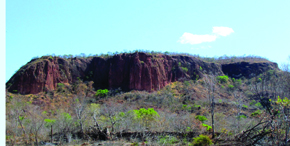 Of the scarcely more than ten craters identified on Brazilian soil, seven have been confirmed to be caused by a fallen meteorite or comet. The most recent to receive such recognition is the Santa Marta crater, a circular structure some 10 kilometers in diameter near the town of Gilbués, in southern Piauí State. During the 76th Annual Meeting of the Meteoritical Society held in Canada between late July and early August 2013, geologists Alvaro Penteado Crósta of the University of Campinas (Unicamp) And Marcos Alberto Rodrigues Vasconcelos, who is pursuing post-doctoral studies under a FAPESP research grant, presented evidence that this scar on the northeastern landscape was indeed caused by the impact of a meteorite.
Of the scarcely more than ten craters identified on Brazilian soil, seven have been confirmed to be caused by a fallen meteorite or comet. The most recent to receive such recognition is the Santa Marta crater, a circular structure some 10 kilometers in diameter near the town of Gilbués, in southern Piauí State. During the 76th Annual Meeting of the Meteoritical Society held in Canada between late July and early August 2013, geologists Alvaro Penteado Crósta of the University of Campinas (Unicamp) And Marcos Alberto Rodrigues Vasconcelos, who is pursuing post-doctoral studies under a FAPESP research grant, presented evidence that this scar on the northeastern landscape was indeed caused by the impact of a meteorite.
The researchers spent time in the crater in late 2012 and collected samples of sedimentary rocks that contained macroscopic and microscopic records of the impact of a celestial body: so-called shatter cones, striated structures that resemble the tip of a Christmas tree, and planar deformation features in quartz crystals. “We don’t yet know the age of the crater for sure,” says Crósta, who will soon publish a scientific article providing more details on the work. Santa Marta is estimated to have been formed between 145 and 300 million years ago, because they found sedimentary rocks there that date from the Cretaceous to the early Carboniferous period.

ALVARO PENTEADO CRÓSTACore of the Santa Marta crater in Piauí: the seventh in Brazil created by the impact of a celestial rock ALVARO PENTEADO CRÓSTA
The site of the new crater, which was first identified on cartographic maps in the 1970s and subsequently in satellite images, has awakened researchers’ curiosity. Santa Marta is, in fact, located in an area relatively close to two formations proven to have emerged as a result of celestial rock impacts: the Serra da Cangalha crater in Tocantins State, and the Riachão crater in the state of Maranhão. All three are located in the Parnaíba Basin and are currently being studied in greater detail by the group at Unicamp in partnership with colleagues at the Natural History Museum in Berlin.
The number of craters found in Brazil is small in comparison with the number identified globally—over 180, with a large concentration in North America, Australia and Europe. This does not mean, however, that few meteorites or comets have fallen here. Meteorites have fallen, but their traces have been obliterated or simply could not be found. “As of yet there has been little research in this area,” Crósta comments.
Republish
